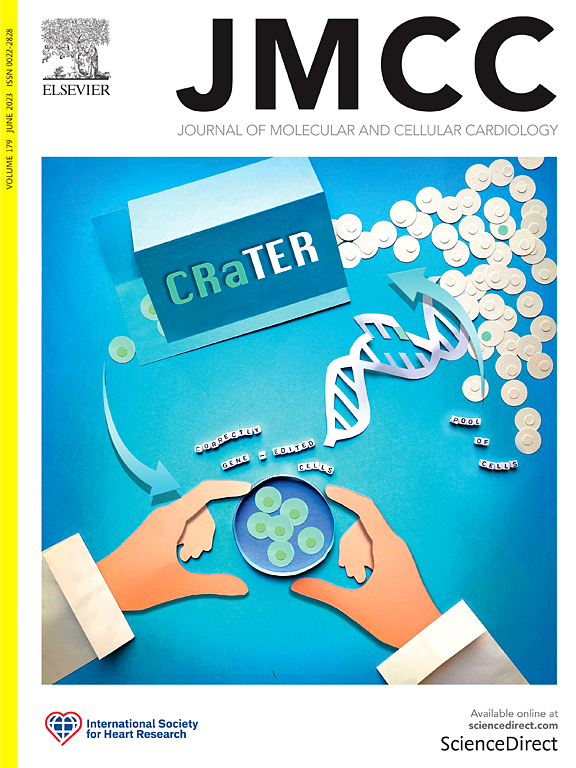心肌的流式细胞术:从猪和小鼠心脏分离的成人心肌细胞的端到端分析。
IF 4.7
2区 医学
Q1 CARDIAC & CARDIOVASCULAR SYSTEMS
引用次数: 0
摘要
心脏内心肌细胞(CMs)和非肌细胞(NMs)的选择性靶向治疗是一个活跃的研究领域。这些新型治疗策略的成功与在临床相关动物模型中准确评估摄取和基因传递效率的能力有关。然而,单细胞水平的定量仍然是一个重大挑战。虽然流式细胞术提供了准确和直接的单细胞定量的可能性,但CMs独特的结构和物理性质使分析复杂化。成人CMs的流式细胞术分析还没有标准化的方法,这是该领域的一个重大缺陷。在这里,我们解决了这一差距,并引入了一种强大的优化方法,用于成功地对分离的CMs进行流式细胞术分析。从组织消化开始,我们提出了一种简单的分离和表征CMs和NMs的工作流程,并在猪和小鼠中进行了测试和验证。我们通过三个生物学相关的应用证明了这种方法的多功能性。首先,我们引入了一个基于DNA含量分布的CMs成核量化模型。其次,我们评估了AAV-Luc在猪心脏中的细胞特异性体内基因传递。最后,我们在压力过载诱导的肥厚小鼠模型中展示了CMs的结构重塑如何影响它们的光散射特性。总之,这些发现为基础和转化心血管研究中的心脏细胞群单细胞分析建立了一个灵活的定量平台。本文章由计算机程序翻译,如有差异,请以英文原文为准。
Flow cytometry of the myocardium: An end-to-end analysis of adult cardiomyocytes isolated from pig and mouse hearts
Selective therapeutic targeting of cardiomyocytes (CMs) and non-myocytes (NMs) within the heart is an active field of research. The success of those novel therapeutic strategies is linked to the ability to accurately assess uptake and gene delivery efficiencies in clinically relevant animal models. Nevertheless, quantification at the single cell level remains a significant challenge. While flow cytometry offers the possibility of an accurate and direct single-cell quantification, the unique structural and physical properties of CMs complicate the analysis. There are no standardized methods reported for the flow cytometry analysis of adult CMs, which is a significant pitfall in the field. Here, we address this gap and introduce a robust and optimized method for the successful flow cytometry analysis of isolated CMs. Starting from tissue digestion, we present a simple workflow for the isolation and characterization of CMs and NMs, tested and validated for pig and mouse. We demonstrate the versatility of this method through three biologically relevant applications. First, we introduce a model to quantify CMs nucleation based on DNA content distribution. Second, we assess cell-specific in vivo gene delivery with AAV-Luc in pig hearts. And last, we demonstrate how structural remodeling of CMs affects their light scattering properties, in a pressure overload-induced hypertrophy mouse model. Together, these findings establish a flexible and quantitative platform for single-cell analysis of cardiac cell populations in both basic and translational cardiovascular research.
求助全文
通过发布文献求助,成功后即可免费获取论文全文。
去求助
来源期刊
CiteScore
10.70
自引率
0.00%
发文量
171
审稿时长
42 days
期刊介绍:
The Journal of Molecular and Cellular Cardiology publishes work advancing knowledge of the mechanisms responsible for both normal and diseased cardiovascular function. To this end papers are published in all relevant areas. These include (but are not limited to): structural biology; genetics; proteomics; morphology; stem cells; molecular biology; metabolism; biophysics; bioengineering; computational modeling and systems analysis; electrophysiology; pharmacology and physiology. Papers are encouraged with both basic and translational approaches. The journal is directed not only to basic scientists but also to clinical cardiologists who wish to follow the rapidly advancing frontiers of basic knowledge of the heart and circulation.

 求助内容:
求助内容: 应助结果提醒方式:
应助结果提醒方式:


